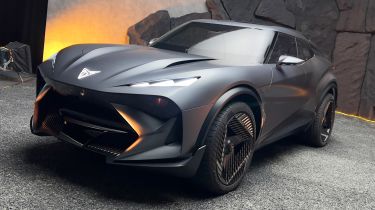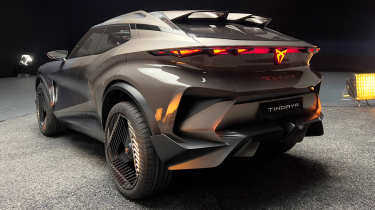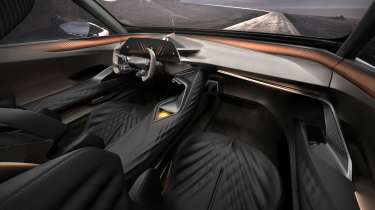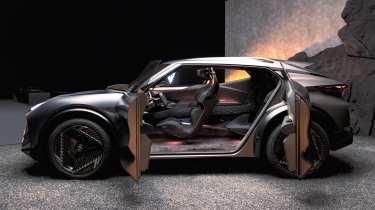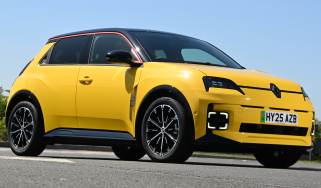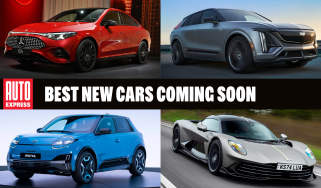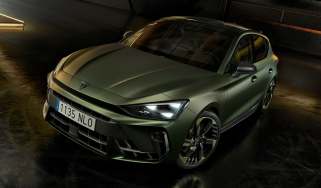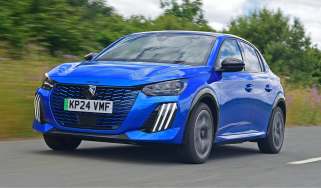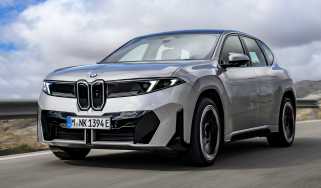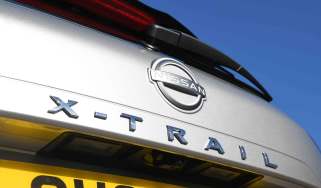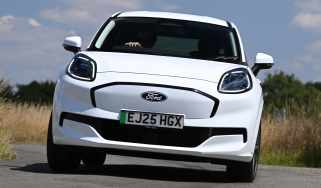New Cupra Tindaya concept previews future BMW iX3 rival
The Cupra Tindaya’s outrageous styling is complemented by a radical cockpit design that puts the driver centre stage
This is not the next Batmobile. This is the new Cupra Tindaya concept, which points the way to a driver-focused flagship SUV that could rival the forthcoming new BMW iX3 and Alfa Romeo Stelvio.
Late last year, Auto Express broke the story of Cupra’s intentions to launch a new range-topping electrified SUV that would sit above its newly launched Terramar and Tavascan.
It was also going to be the car that would lead the brand into the US market, although that plan has been postponed for now. Nevertheless, the Tindaya indicates Cupra is still up for the challenge of taking on what BMW, Alfa Romeo and others have to offer.
The dramatic concept also shows us the next evolution of the brand’s design language, and how it will continue to prioritise the driving experience, by putting even more focus on the person behind the wheel. The idea that drove the creation of the Tindaya was simple: “No drivers, no Cupra.”
A production version of the Tindaya is unlikely to arrive until closer to the end of the decade. In the meantime, though, you can save more than £11,000 on the all-electric Cupra Tavascan coupé-SUV through our Buy A Car service, and it’s available to lease from less than £300 per month.
What was the inspiration for the Cupra Tindaya?
The Cupra Tindaya is named after a volcanic mountain on Fuerteventura, one of the Canary Islands. The hue of the mountain’s rock closely resembles the brand’s signature copper colour, worn by all its cars. The paint also shifts from a deep metallic grey, inspired by the Atlantic Ocean that surrounds the island, to a warmer desert sand hue that represents the mountain.
At the front, Cupra’s ‘shark nose’ design from the Tavascan and Terramar has been taken to a new extreme. Completing the car’s megalomaniacal expression is a sharper take on the brand’s three-triangle headlight signature, a heavily sculpted bonnet and huge pincer-like elements in the bumper made from transparent Perspex that glow thanks to lights embedded inside.
Below the illuminated Cupra badge is a digital panel that projects a ‘welcome ceremony’ when the Tindaya comes to life, and graphics that change depending on which drive mode has been selected.
The Tindaya rides on 23-inch wheels with a highly complex design based on the brand’s emblem. Meanwhile, the rocker panels have a rippling effect, which was inspired by muscle tissue. The way those panels curve underneath the car also makes it look much higher off the ground.
Rather than a typical, blocky SUV, from the side you can see the Tindaya is a cross between a fastback and shooting brake estate, which reminds us of the Cupra Formentor. It’s a very dramatic and athletic silhouette, with the enormous bonnet stretching out in front and a thin glasshouse that tapers towards the rear, along with the roofline.
However, the rear of the Tindaya makes the rest of it look subtle. The sculpted wheelarches are contrasted by more glowing slashes and fins on either side of a massive diffuser, plus there’s a twin-fin roof spoiler and a ‘coast-to-coast’ light bar with, of course, another illuminated Cupra logo sitting pride of place in the centre.
Interestingly, the rear haunches and tailgate aren’t painted, allowing us to see the natural fibre composite that’s been used in place of the usual carbon fibre. It looks identical and has many of the same qualities, but is one way Cupra is showing its consideration for sustainability.
What’s it like inside the Cupra Tindaya?
If nothing about the Tindaya’s styling managed to catch your eye, the inside surely will. A set of coach doors open up to reveal a radical new cockpit design for Cupra.
It ditches the familiar central touchscreen and puts all the vital driving information, plus navigation and media, on a 24-inch curved display directly in front of the driver. Similar to BMW’s new Panoramic iDrive set-up, certain key information and widgets are also projected along the bottom of the windscreen to help the driver keep their eyes on the road.
Everything is controlled via the motorsport-inspired steering yoke, which features an array of physical switches and two large dials, one of which activates a Boost function. However there is also an AI-powered voice assistant on board that can lend a hand.
Ruben Rodriguez, Cupra’s head of user experience and interface design, showed Auto Express around the Tindaya before its reveal at the Munich Motor Show. He explained to us that this interior “is a vision of where we would like to get in the future. This is how we express that idea: ‘No drivers, no Cupra’.”
There are spaces for up to six shortcut buttons around the display, which change depending on which experience mode has been selected. To do that, you tap a corner of ‘The Jewel’ that sits in the centre console and which Rodriguez describes as the “heart” of the Tindaya.
‘Immersive’ is designed to provide a calm, relaxed driving experience, with information on the driver’s display reduced to the essentials and occupants surrounded in warm ambient lighting. Meanwhile, ‘Connected’ mode offers much more information, with AI helping to pick which content like apps and services are displayed along the windscreen.
Finally, there’s ‘Rider’, which is the equivalent of Sport. Activate this and the ambient lighting changes to a neon purple and green, while the touch-sensitive buttons now offer shortcuts to turn off the traction control or adjust the suspension. The driver’s display shows information like g-forces and level of regenerative braking, while the speedo moves on to the windscreen, directly in front of the driver.
Each experience mode also provides a different soundtrack. “In Immersive, you have a sound that is more chill, more calm, then for Rider you have a sound that gives you more energy. But they are all based on the same concept of mixing raw sounds with digital glitches,” continued Rodriguez.
Importantly, Cupra isn’t trying to replicate the sound or emotive quality of a combustion engine. “We are embracing the new generation of mobility and we don’t think that has to be based on the past.”
Part of the Tavascan’s interior is a central spine that connects the centre console and dashboard. Once again, the Tindaya takes a familiar element and pushes it much further, with the concept’s spine running through the entire cabin, from the dashboard all the way to the boot. Towards the back are harder materials that resemble rocks from the Tindaya mountain.
At 4.7 metres long, this is the biggest car Cupra has ever made and, coincidentally, nearly exactly the same length as the latest BMW X3. However, the Tindaya has only four seats, more like a Lotus Eletre, with a 2+2 configuration and what are supposed to be a future evolution of Cupra’s CUP bucket seats. The upholstery is bio-based vegan leather, while the headrests are made from 3D knitting.
What platform and powertrains does the Cupra Tindaya use?
Underneath all that scalpel-sharp bodywork is the Volkswagen Group’s brand-new Scalable Systems Platform (SSP). This architecture will eventually replace the well-utilised MEB (mainstream) and newer PPE (premium) tool kits, and be the “single backbone for the Group”, as former VW boss Herbert Diess put it in 2021. It will be used by various brands from Skoda to Porsche and even Lamborghini.
Thanks to this platform, Cupra says the Tindaya can accommodate two types of powertrains: fully-electric or range-extender hybrid, which is what the car we got to look around supposedly featured. It’s a technology the Volkswagen Group has recently begun investing in and plans to bring to Europe in the coming years.
Under the Tindaya’s enormous bonnet is a 1.5-litre four-cylinder petrol engine and its sole purpose is to generate energy for two electric motors. There’s one up front, and another at the rear, which deliver all-wheel drive and a combined 489bhp. 0-62mph should take 4.1 seconds, which would make this the quickest car Cupra has ever made.
Arguably more impressive than the performance is, with that petrol generator on board, the Tindaya can supposedly cover more than 621 miles in one go. That’s enough to get from London to Paris and back, without stopping. Cupra hasn’t said how big the car’s battery is, but apparently it’s good for a pure-electric range of around 190 miles.
Did you know you can sell your car through Auto Express? We’ll help you get a great price and find a great deal on a new car, too.
Find a car with the experts

